This is a Winter Argos Catalogue from 1998. For those outside the UK, Argos is a shop which sells, well pretty much everything, but it’s all kept out of sight behind the counter. Instead of browsing real products, everyone enters a room with catalogues spread out. You then order by browsing the catalogue, writing the product number down and handing this slip to an employee, who proceeds to bring out a your item, as if by magic.
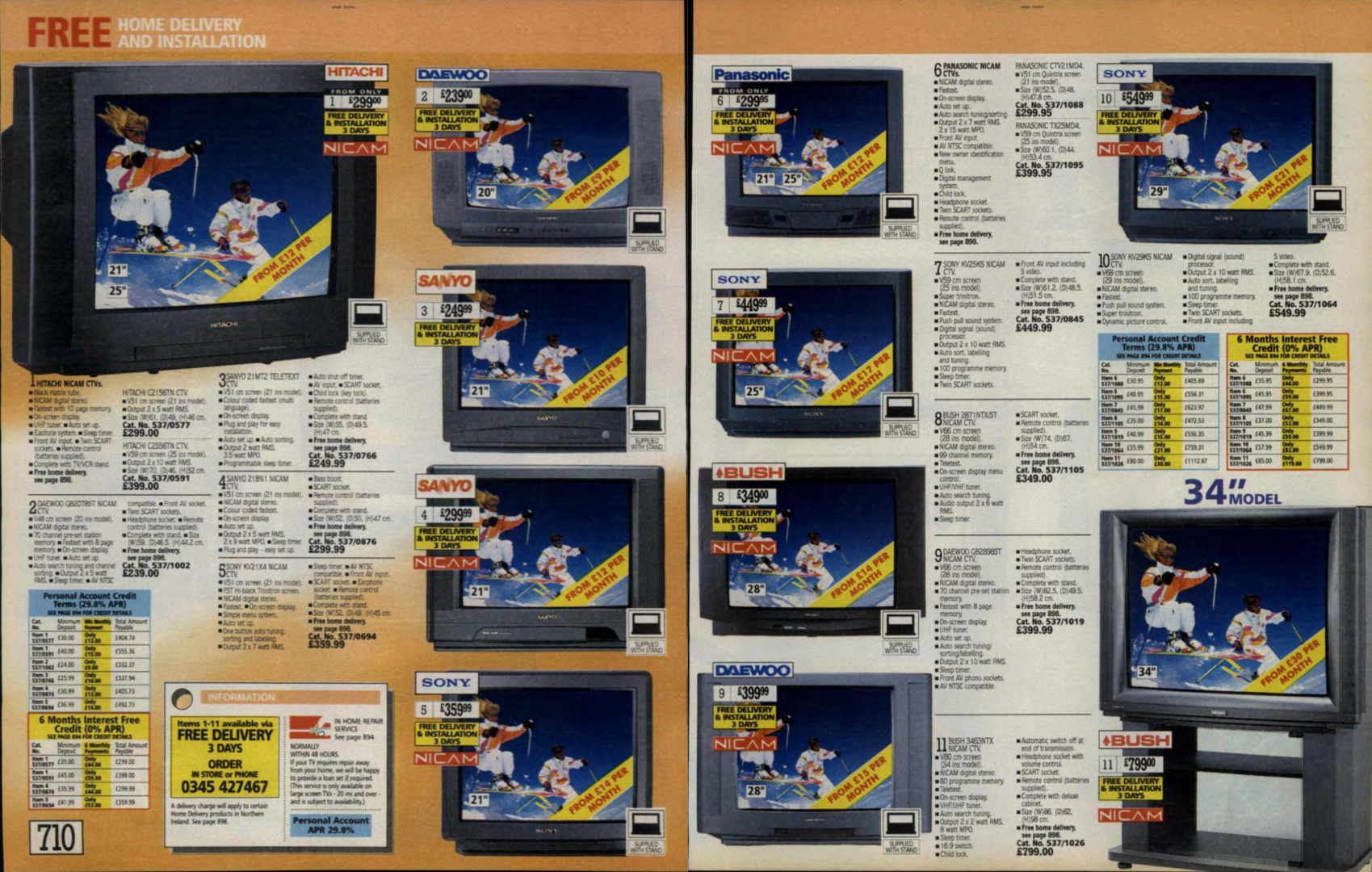
However, there is no chance in hell they would have ever been able to bring out this absolute mammoth of a television. THIS is the Toshiba 3787DB. It’s a 37″ CRT released in 1998, and it’s the largest 4:3 aspect ratio TV ever released in the United Kingdom.

And by that, I mean CRT…. The largest CRT Argos could muster in 1998 was this huge 34″ BUSH model priced at £799, and good lord, that would have been hard enough to move. Most families would have owned something like this, a 21″ model, if you were lucky it might even have had Teletext. You could get bigger rear projection units, but they don’t even come close to a CRT screen, especially when you try to watch one from a side angle.
If you were lucky enough to have a TV in your bedroom, it might have been a garish all in one unit, like this 14″ Crown with integrated VCR. I would say about 1 in 20 people who come in this bar, tell me this is the exact TV they had when they were younger.
But this was a critical point for TVs. This was the time when widescreen models were starting to land, with the richest families snapping them up, for that home cinema experience.
But this, this thing is obscene. Whereas you could probably lift a modern 37″ LCD TV on your own without difficulty, this thing took 3 people to get it in here. It’s almost like a last Hurrah from Toshiba for the 4:3 aspect ratio, and that’s exactly why we need to look at it.
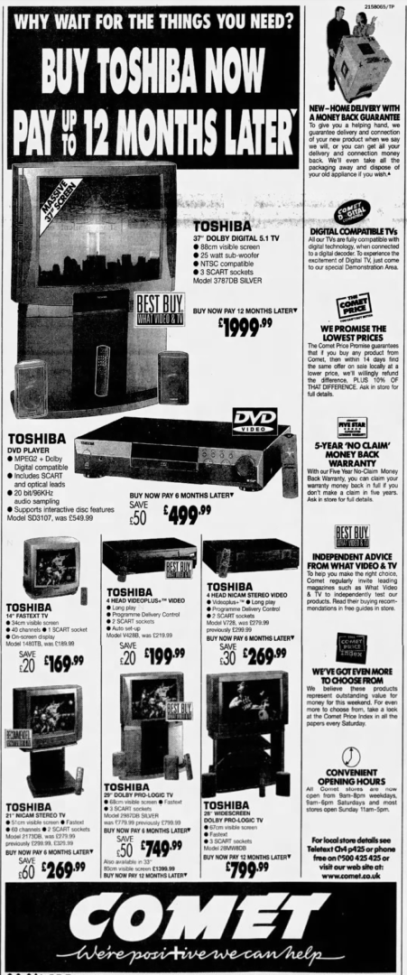
£1999. That was the price this chonker was sold at in 1998. That equates to £3,693.23 today, or $4,674 American dollars. It quickly accumulated a number of critic awards, including, the Home Entertainment Awards 1998 Best TV winner, a What TV & Video award and the Best Buy Home Cinema choice. You might think with Widescreen coming in, it would be a bit silly to buy a 4:3 screen at this point, but 4:3 would remain the norm well into the noughties, plus widescreens at the time just looked tiny in comparison.
Measured diagonally, 36″ is the viewable screen size. But the tube itself is 37″. If you sat on your lounge floor playing PlayStation with this, you’d definitely get square eyes. It’s huge, and although you could get slightly larger TVs in America, like this 40″ Mitsubishi beast demonstrated by the channel Retro Tech USA, which for commercial use actually went up to a Sony rivalling 43″, this was the largest consumer direct tube 4:3 our little island could muster.
The TV alone measures 1m wide, 78cm tall and 65 deep, and weighs over 80KG. Under normal load it sucks 218 Watts of power, and it consists of all these components. Honestly, it shocks me that anything works when I look at lists like that, let alone that they still work decades on.
Now being from 1998, this thing has an analogue TV tuner. That’s not much use now-days, and it would be a crying shame to connect a game console up to this thing via an RF lead. But, thankfully we are treated to a number of other connections.
But before we connect anything up, let’s address the elephant in the room. The TV Stand. This stand comes with the telly as standard, mainly because it would likely turn your average TV stand to absolute dust. Measuring 1m wide by 78cm tall and 65cm deep, the TV is a beast, and that’s without the stand. It’s actually quite a cool stand too, you can open it fully up, and then you’ve got three shelves to put your Sky box, VCR and of course Philips CD-i on, along with two side compartments for VHS tapes or whatever, as long as they’re not in an oversize case, anyway.
From the back we can then access all the wiring we need to, although if you had this thing shoved in a corner, then this would be an absolute nightmare. Anyway whilst we’re here, let’s go through the main connections.
So, on the left here, we’ve got 4 speaker outs for the surround speakers that the TV shipped with brand new, then we’ve got a whopping 3 bidirectional SCART connections, which allows input and output of RGB, Composite and S-Video, although the 3rd SCART connection also has parallel S-Video and audio inputs, which are also shared with the front connections… I’ll get to those.

We’ve also got phono audio outputs here, digital audio input over there, and of course our RF connection for plugging in an aerial, or anything else you like. It’s pretty well featured, as you might expect.
So, it’s easy enough to connect our CD-i up using a SCART cable, and then we can get a look at what this thing can do.
Now, let me tell you, turning this thing on is a harrowing experience. The absolute clunk you hear followed by a whoosh of static is pretty unnerving. If the tube on this thing imploded, you would certainly know about it.
But the quality is evident straight away. Just look at how clear everything is. The screen is so big that, you can, of course, see visible scanlines, and there’s very little distortion even at the edges.
This thing is packing the latest tech, that Toshiba had to offer. That includes an FST tube, making the screen flatter than normal, although with a screen this size, you can very much still see the curvature (don’t tell flat earthers). The shadow mask features INVAR technology, a special nickel alloy that resists thermal expansion, allowing the tube to operate at higher voltages, and display more vivid whites. Super Scene Control improves picture contrast, along with a dark glass tint, apparently providing up to 18% more contrast than a standard Toshiba TV.
It certainly does look good. But then there’s also a plethora of controls to play with, for which you’ll need this hefty remote, including a secret slidable section, for those lesser used buttons. Nice. Honestly, about half of the manual is dedicated to this lump hammer of a wand. It tells you how to change the surround sound, what effects you want, how to set a timer, noise reduction, have this blue screen kick in instead of background radiation, how to change inputs, how to use Teletext, how to change the Teletext font, how to use Nicam dual language broadcasts, how to change the picture brightness, colour, tint, sharpness, etc, etc. There’s enough here to keep any Dad happy for days. It even tells you how to Prepare the remote control.
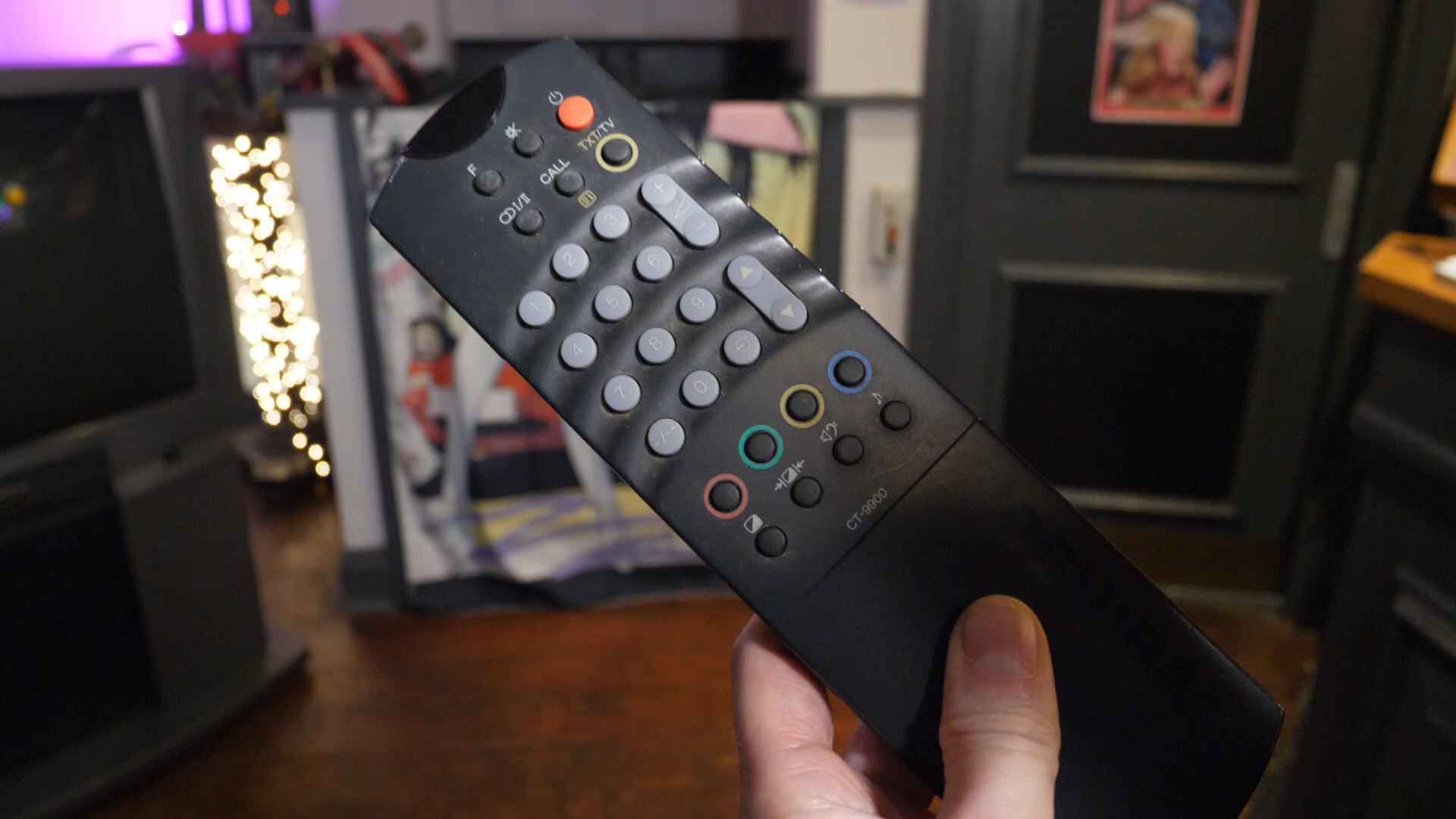
If you hold down the Mute button on the control and press the Menu button on the TV, you can actually enter the service mode menus, which allow you to check the screen geometry, run a self diagnosis and anything else a Toshiba engineer might like. There are various screens for assessing and adjusting the image. I imagine it hasn’t been calibrated for about twenty years, but it’s actually not bad.
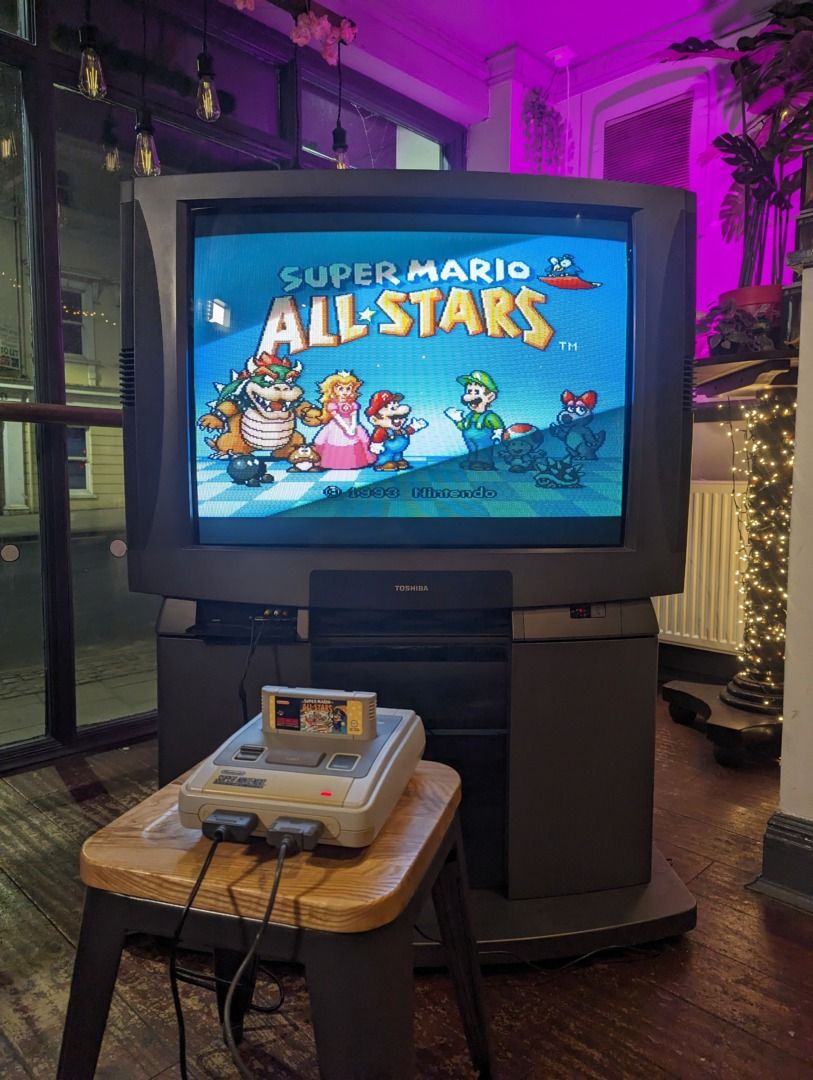
Anyway, let’s get back to business. Let’s plug a Super Nintendo into this thing.
Now for that, we’ll need to reveal the front connectors, which include headphone out, an S-Video in, along with composite and audio connections. The Super Nintendo can do S-Video, so let’s see how that looks. One really cool feature here, is that you can route these wires out the bottom and close the front door again, so it looks tidy…. neat… literally.
Whatever game you play, it looks fantastic, honestly. It’s no wonder that this TV is highly sought after among Retro Gamers, who have the space for it at least. S-Video might not be up to RGB levels of clarity, but it still looks pretty damn nice here. Now obviously, this is running the PAL picture format, so we’ve got borders at the top and bottom. Things would look a little more impressive with an NTSC console, which actually this TV can handle, at 60Hz. Which is pretty unusual for a 90s CRT in this region.
Ahhhhhh, now we’re talking. Now, this is the game we need to truly see this set in action. Rise of the Frickin’ Robots.
JUST LOOK AT THAT.
Such stunning visuals. Only compounded by the sheer vibrancy of the Toshiba 3787DB.
Absolutely incredible scenes.
Tell you what. Let’s hook up a Mega Drive, with it’s true RGB out and see how that looks.
HOLY MOLY.
THIS IS WHERE IT’S AT.
MY GOD.
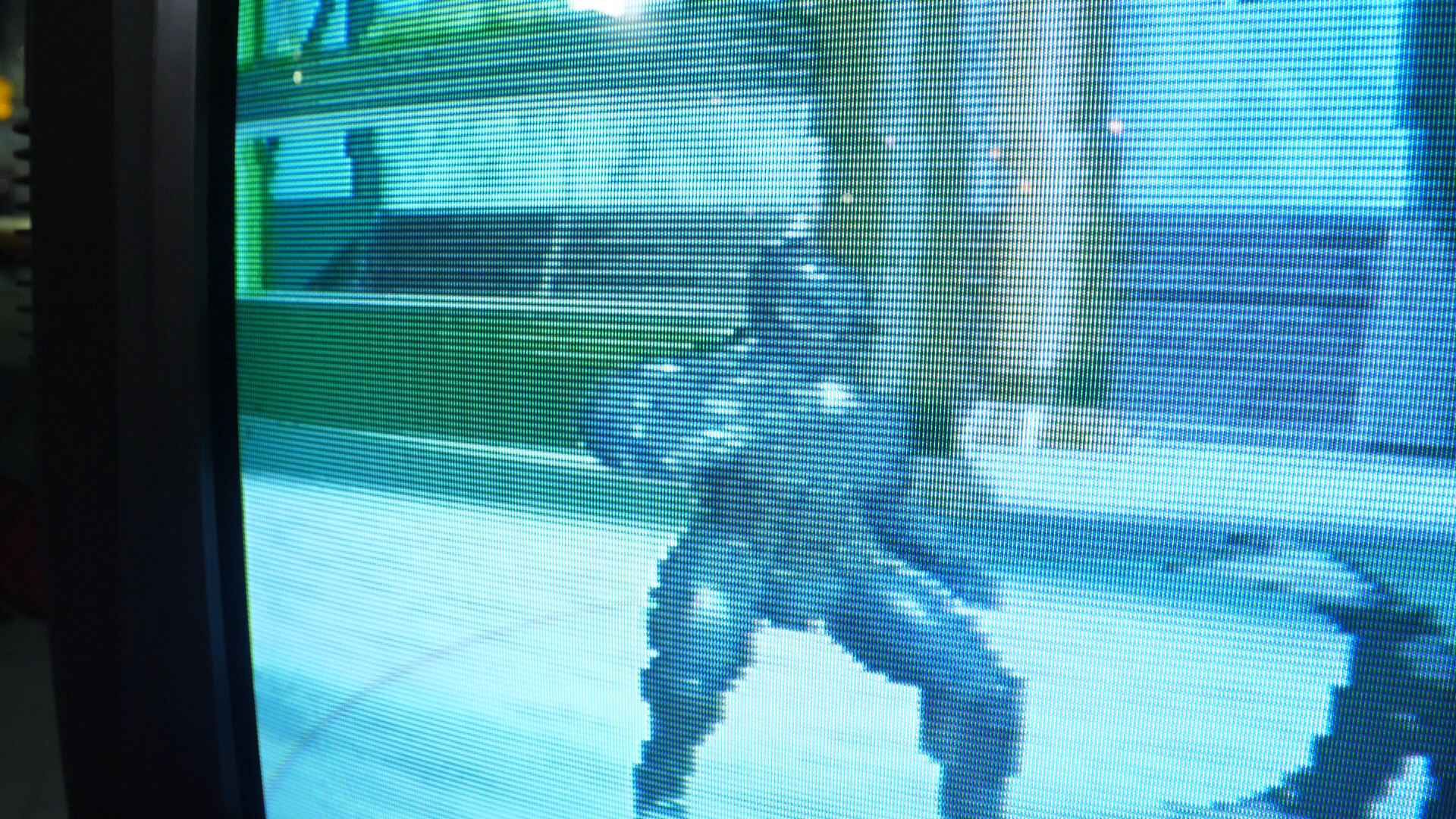
No, but seriously. The Mega Drive looks incredible on this screen. Even when you squish it into 16:9 mode, it still looks good.
But it not only looks great, it also sounds great.
This thing has two 15W side speakers, a 15W centre speaker and a built in 25W Sub Woofer. It’s advertised as having an 11 speaker 100W RMS audio system, which when you chuck in the surround speakers and tweeters makes sense.
It’s got Dolby 3 Stereo, Dolby Digital Surround, Dolby Pro-Logic Surround, Digital Surround Processing and of course, Nicam Stereo.
From your perspective, you’re only hearing a sound as good as my camera’s microphone and your speakers can muster, but from here, it sounds great. We’ve got punchy bass, vibrant treble and that’s without the surround speakers attached, which sadly I don’t have.
Firing up a CRT like this, is a completely different experience to our modern flat screens, and I don’t just mean the sheer scale of them. A CRT feels like it’s got life, it feels like a hulking animal that lies dormant until it’s awoken in a burst of glory. It’s a bit like when Train nerds bang on about Steam engines and how they feel like living, breathing creatures compared to modern locomotives.
All you need to do is look at the comments on CRT threads and videos to get that vibe;
Wow. The old neon glow of a CRT. Missed so much.
Dude it’s literal perfection. You also look like an ancient electronic wizard with the wand lol.
that crt sound bleeds through the video and hits me with nostalgia and tinitus at the same time.
Nothing beats the comforting glow of an old CRT.
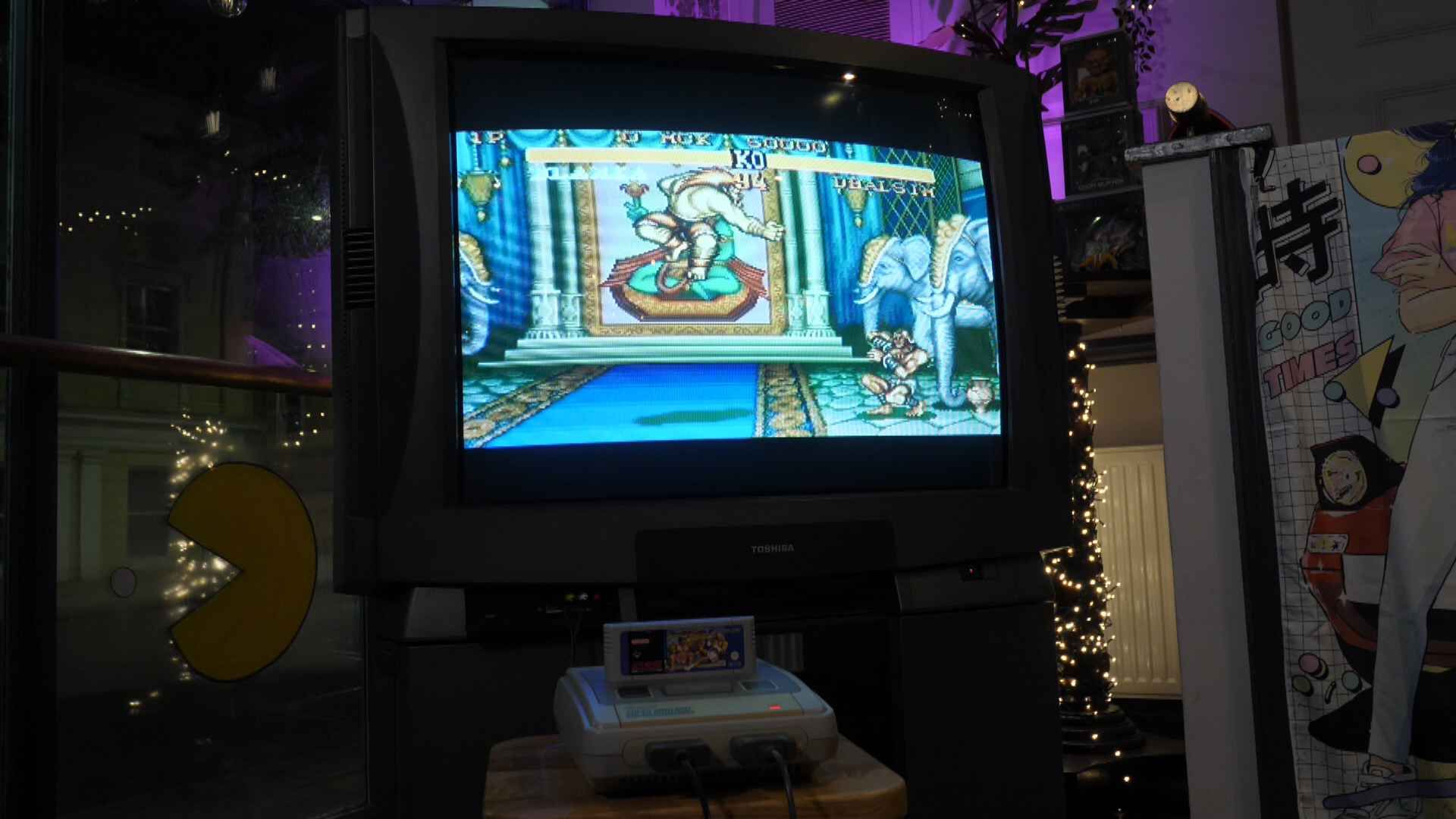
And it really doesn’t. That strobing light that builds up your CRT image, not only gives out a comforting glow, but because the image is literally created by a moving light, which our brain translates to a static picture, the images look incredibly sharp. So when you remember low resolution images looking great on these boxes, it’s not just rose tinted spectacles.
Those CRT TVs are the only thing keeping this universe together. Don’t let them fall or a supernova could break through the universe.
And that’s exactly the kind of energy these things give out. Like they’re fragments of the past, that are holding the universe together. The reality is, they’re holding our memories together. We spent so much time sat around one of these growing up, whether watching Philip Scoefield get slimed on Noel’s House party, or hooking up our Commodore 64 and playing for hours on end. We probably spent more time watching these than talking to our families, and for that reason, they feel like an old friend.
So, this beast from Toshiba, it’s a billion memories all tied up into one.
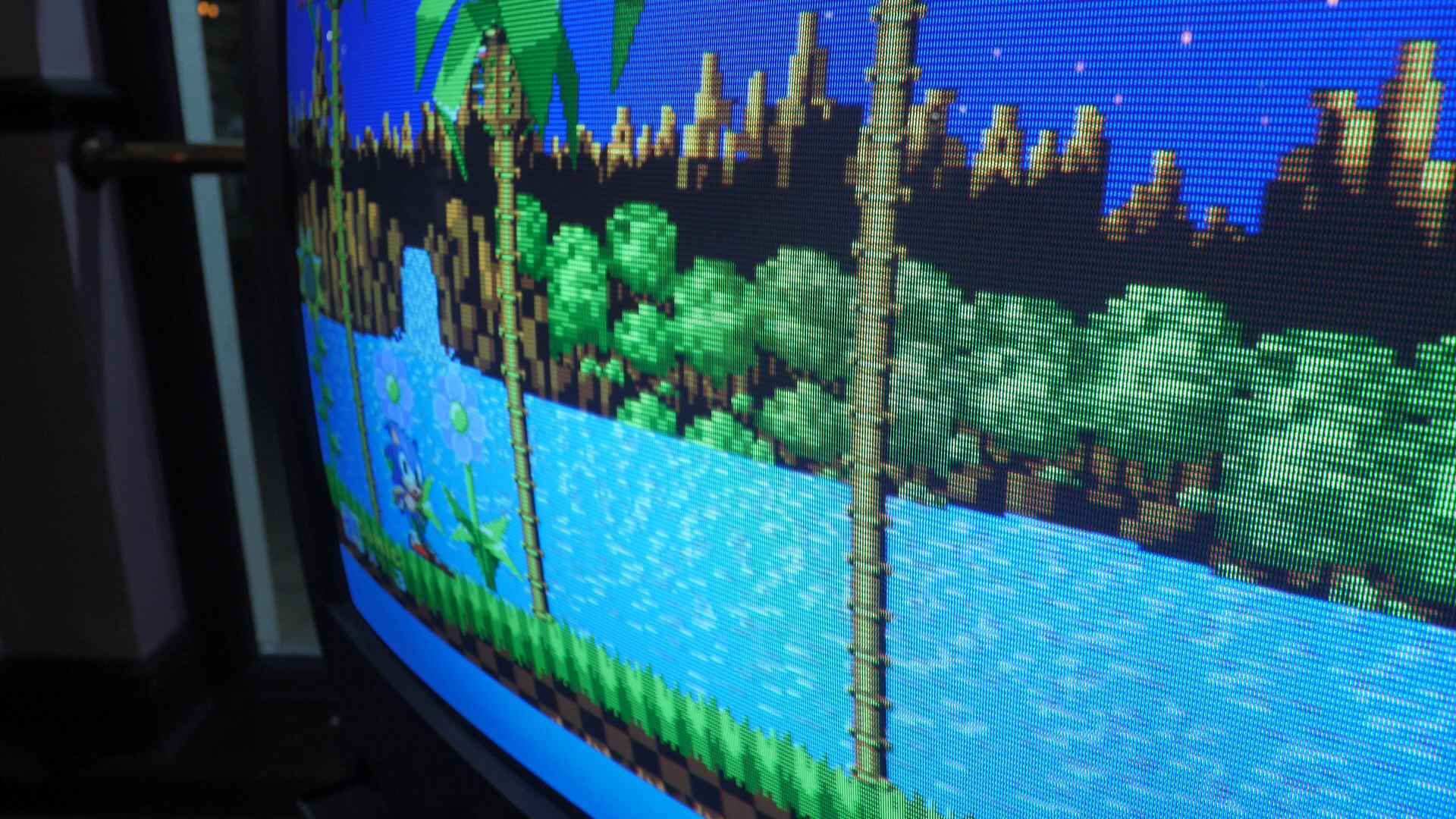
Most people who see this TV, swear blind that they had the exact same model in their family living room. It’s probable they had one of the smaller models, maybe the more popular 29″ model, which just seemed bigger at the time, because these ones are incredibly rare. Now we’re blessed with huge widescreens we tend to think that TVs were always huge, but nope, only a very few were back then.
You might think the heft of these would make them a natural burglar deterrent, but actually, as the Tamworth Herald reported on 31st December 1999, one was stolen from the house of a pensioner using a wheelbarrow. Let’s hope they dropped it on their feet.
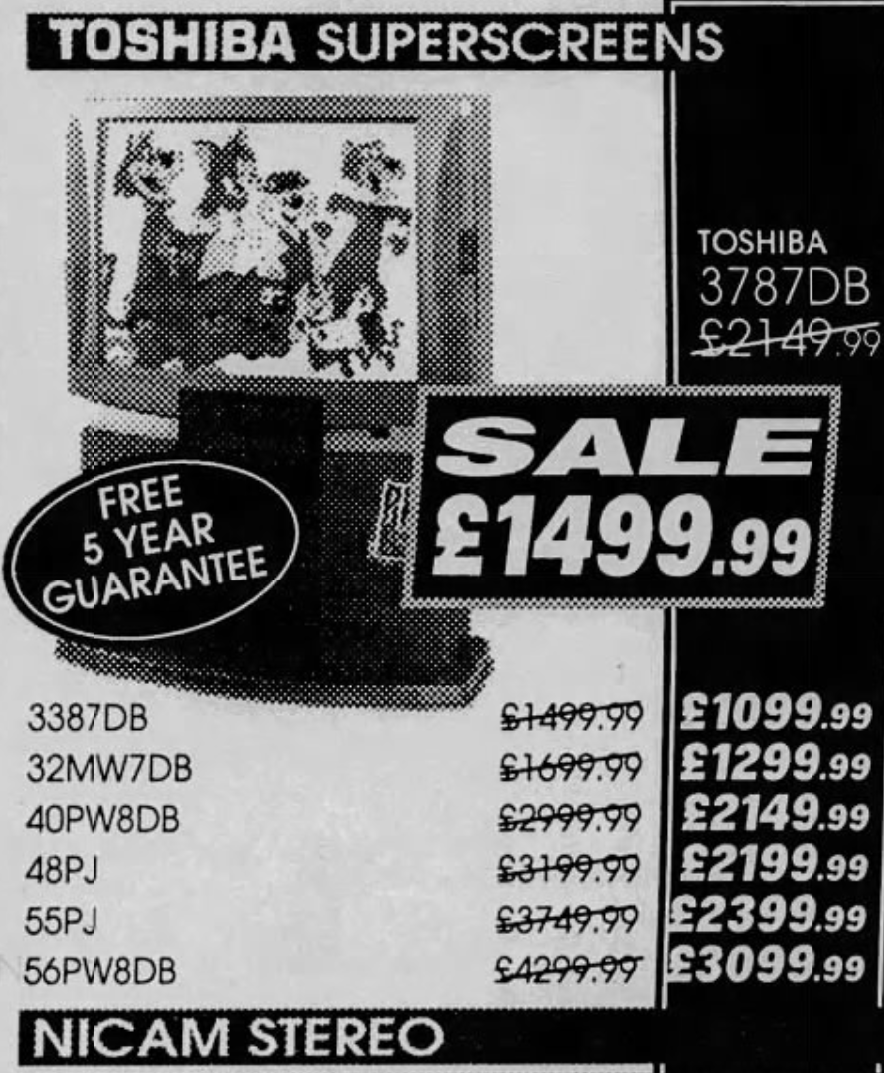
Toshiba would stop making this particular model within a couple of years. Toshiba were pushing their own Widescreens at the time, and even by January 1999, many outlets had slashed the price of these huge hulkers, only for it to drop further and further before the Millennium was out. Apparently you can get a 100Hz version, but it wasn’t enough to compete with the introduction of digital television along with widescreens, and plasma flat screens. TVs which lacked the soul of the CRT, and for that, this and models like it will always remain in our hearts.

Anyway, it’s stuck in the corner at Barcadia from now onwards, so if you want to relive that blast of nostalgic radiation, then come and check it out. You might even be able to play Rise of the Robots, if you’re lucky.
Related threads;
/ anyone_can_help_identify_model_or_know_any…
/ just_acquired_this_toshiba_3387db_love_thi…
/ toshiba_3798db www.avforums.com/threads/tosh…
www.avforums.com/threads/larg…

Nostalgia Nerd is also known by the name Peter Leigh. They routinely make YouTube videos and then publish the scripts to those videos here. You can follow Nostalgia Nerd using the social links below.




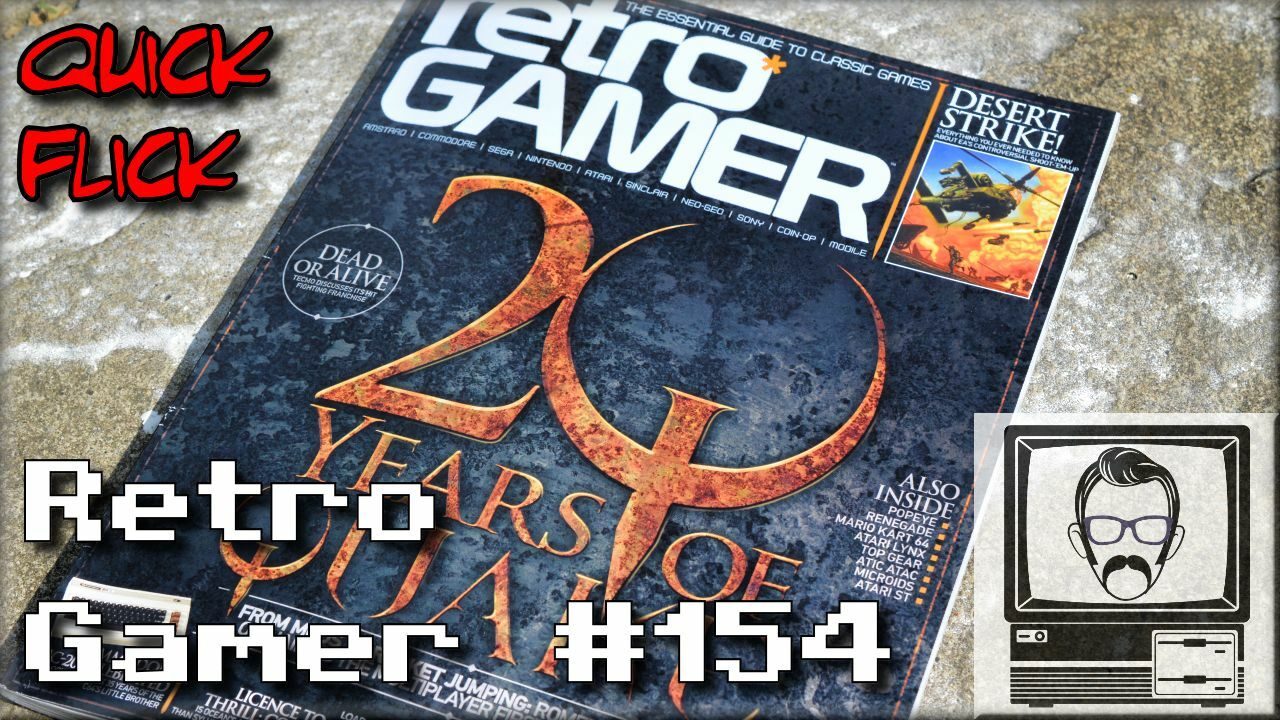
1 Comment
Add Yours →I had this (and the 33″ which I still have). It was immense, I loved every second of watching it and playing games on it. It took 3 people to reliably move and with the stand, would fill a bay window. In fact I had to sand down my window sill for it to fit properly.